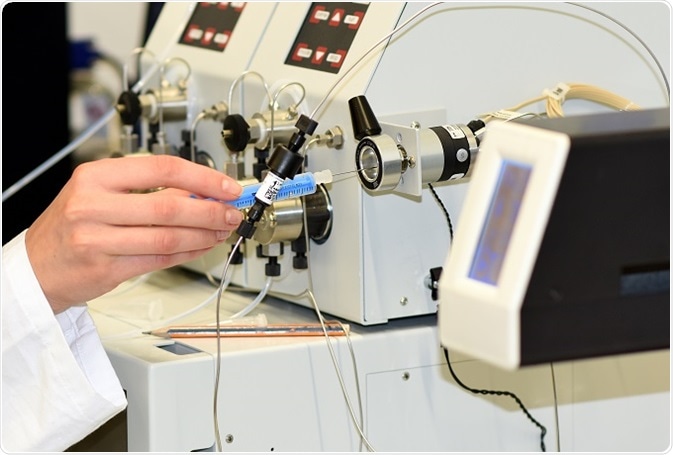Analytical chemistry is a science in which materials are separated, identified and quantified. The techniques used in this branch of chemistry are defined as the chemical or physical principles employed to study a substance which is to be analyzed (the analyte). The techniques for carrying out these aims may be combined or each may be done separately. The identification of the matter under study is performed using qualitative analysis, while quantitative analysis is used to determine how much (relative concentration or total amount) of the substance is present in the analyte.
The techniques used in analytic chemistry include:
Classical techniques
Classical qualitative techniques
Separation techniques
-
Precipitation: This is a gravimetric method in which the reactants and products of a chemical reaction are used to analyze a substance. The metallic ions of many elements may enter into a reaction with the negative ions to form a new insoluble substance called the precipitate, which settles to the bottom of the solution. This is filtered out and washed. The mass of the precipitated solid is entered into the relevant chemical equation to calculate the total amount or relative amount (concentration) of ionic compounds in solution.
-
Extraction: This is a procedure in which a substance is removed from a matrix, both being in two immiscible phases. A classical example is of the extraction of an organic compound from an aqueous phase into an organic phase. The most commonly used technique for the extraction of a compound from an aqueous solution is liquid–liquid extraction (LLE). The movement of the solute is based on the equilibrium condition of the two phases, as described by the partition theory. Solid phase extraction (SPE) is a widely used method of sample preparation used to separate and enrich purified components from aqueous solution. Many advanced extraction techniques are also being developed.
-
Distillation: This is a process of evaporation and condensation by which a component is separated out of a mixture of liquids. It is based upon the difference in boiling points or volatility between the various substances present in the mixture.
Identification techniques:
These are based on color, odor, melting and boiling points, radioactive or reactive properties of the analyte.
Classical quantitative techniques
-
Titration methods include acid-base or complexometric titration. Acid-base titration helps quantify an unknown acid or base in solution by finding its concentration based on the exact amount of opposing base or acid required to neutralize it. It is based on the neutralization reaction. Complexometric titration is a form of volumetric analysis. The end-point of the titration is the formation of a characteristic colored complex, which is usually a metal complex. Thus mixtures of metal ions can be characterized.
-
Gravimetric techniques use precipitation or volatilization to determine the mass of the analyte from its ionic mass. Various techniques are used, such as precipitation, volatilization, or electroanalytical.
-
Coulometric techniques: This set of techniques helps to determine the mass of matter transformed by electrolysis from the amount of electric current used or produced during the reaction.
Instrumental techniques
Instrumental techniques are increasingly employed at higher levels of research, and the same instrument is often sufficient to separate, identify and quantitate the analyte.
Instrumental separation techniques:
This technique uses a mobile phase into which the mixture is introduced. This is passed through the stationary phase. Due to the different rates at which the components of the mixture travel through the stationary phase, they can be separated. The travel speed is based on the partition coefficient of the compound which determines the time of retention on the stationary phase.
High performance liquid chromatography (HPLC) is a technique in which the analyte is contained in a mobile phase (such as methanol or acetonitrile with water or buffer solution) passed through a stainless steel column which is between 1 and 25 cm long and less than 1.0 mm to 4.6 mm in internal diameter, filled tightly with particles of micron size allowing the various components of a complex non-volatile mixture to separate rapidly.
The final concentration is determined using computerized calculations based on the outputs at varying amounts of the organic compound.

Credit: smereka/Shutterstock.com
This employs an electric field to separate particles in a fluid because of the development of a charged interface between them
In this technique a fluid suspension or solution is fed through a narrow channel and a field is applied at right angles to it, causing the particles within the field to separate because of their varying mobility in response to the field force.
Instrumental qualitative and quantitative techniques
These may utilize light, electromagnetic, heat and combinations of these to identify the analytes, including:
-
Spectrometry: This uses instruments which can isolate particles based on various properties such as mass, momentum or energy. It includes techniques such as ion-mobility spectrometry based on the mobility of ionized particles in a carrier gas, or mass spectrometry which measures the ratio of the mass to charge of ions.
2.2 The Mass Spectrometer
-
Spectrophotometry: In this technique, a material or component is identified by its reflection or transmission of light, which depends on the wavelength. It may be based on the use of visible, near-ultraviolet or near-infrared light. It may be used to study gases, solids or solutions.
References
- https://www.newcastle.edu.au/course/CHEM2110
- https://www.ntnu.edu/studies/courses/KJ2050#tab=omEmnet
- https://www.csudh.edu/
- https://ustc.edu.cn/
- https://en.wikipedia.org/wiki/Field_flow_fractionation
- https://en.wikipedia.org/wiki/Spectrophotometry
- https://www.oswego.edu/index.html
Further Reading
Last Updated: Jul 20, 2023